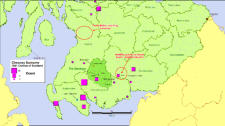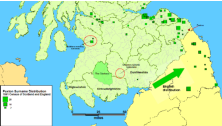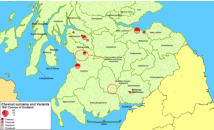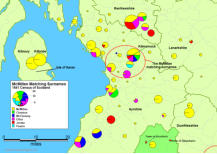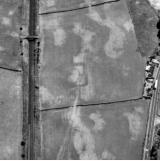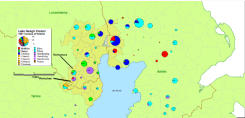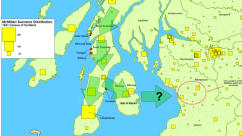
© J.H.Mathieson


Review: The Scottish Origenes McMillan Case Study
Scottish Origenes claim to define a surnames “genetic homeland” by identifying geographic areas where
farmers with matching surnames identified in DNA tests cluster. In this case a small area with a 5 mile
radius in northern Dumfriesshire is identified as the McMillan's "genetic homeland”.
A number of serious issues have been identified in this case study
which call into question both the study's conclusion and the methods
used by the author to identify "Mr. McMillan's" genetic homeland.
•
The case study relies on low resolution DNA tests to identify
deep genetic ancestry. The study's conclusions concerning the
location of the McMillan "genetic homeland" are based on the
interpretation of 25 and 12 marker tests with a genetic distances of 4 or 5.
•
The study ignores the clients own DNA test results, historical records, and clan history. Had this
material been relied on it would have pointed, not to the borders of Scotland, but to Ayrshire and
Knapdale as the probable homeland of "Mr. McMillan's" early ancestors.
•
Surnames are picked from an extensive list of low resolution Ysearch matches to prove that the
McMillan "Adam" took his surname in the borders of Scotland. Surnames which did not yield
satisfactory results were changed to suite the needs of the study's preconceived goal.
•
The cartographic techniques employed in the study are rudimentary and simply don't meet the
challenge of portraying the complex interrelationships inherent in surname distributions. The
approach is highly selective and focuses only on an extremely small subset of data which supports
the studies preconceived beliefs, while ignoring the distributions as a whole.
The Farmer argument:
The reliance on farmers as a marker to identify the location of a genetic homeland is a fundamentally
flawed principle. The assumption that farmers persist for a 1000 years or more farming the same land is
a belief that simply doesn't stand up to serious scrutiny. Farmers constituted less than 3% of individuals
recorded in the 1841 Census of Scotland. Are we to assume all Scotsmen descend from this small
group? Clearly the answer is no.
The border region of Scotland is not a monolithic farming region, and like the north of England
surnames were not widely adopted there until the 14th century. It was a region historically dominated by
cattle raising and reiving. There are scores of occupations in the region that would prove to be as
"ancient" as the venerable farmer. The genetic link to the past could just as easily be passed thru the
village smith, or the local herdsman, both of whom may have broken their direct link to the land many
generations ago. To assume that if we find the farmers we have found the genetic ancestor of a test
subject is a specious argument.
The study makes it appear this is a straightforward process:
"By plotting the location of farmers called Chesney/McChesney, Glendining, Paxton and Elliott it
reveals that these surnames are all associated with Southern Scotland and that the majority
cluster close to a McMillan farming cluster centred upon Dumfries-shire".
While we can't expect a report of this nature to provide all the background research on which it is based,
we should expect truth in advertising. What are we shown? The locations of three Chesney farmers and
two McMillan farmers. We are left to conclude that the remaining farmers "cluster close to the McMillan
farming cluster". Nothing could be further from the truth. Confining the analysis to the lowlands of
Scotland to be in sync with the study's assertion, we find there are 104 Mcmillan Chesney/McChesney,
Glendining, and Elliott farmers. The genetic homeland covers an area of approximately 70 sq miles. In
order for a majority of farmers (50%) to be considered close to the McMillan homeland, an area covering
3600 sq miles of the Scottish lowlands would need to be included. And what of the Paxton farmers?
There are none.
The DNA Evidence:
Origenes relies on matches found at 12 and 25 markers to people with other surnames (using matches
from both Family Tree DNA and Ysearch), saying, “these recurring surnames are more likely to reflect
the surnames of one’s medieval ancestor’s neighbours.” It is also indicated in Figure 1 that they all
belong the R-M269 haplogroup. R-M269 is a very large haplogroup with many known subclades that
branch away from each other well before surnames were taken, the period in which Origenes attempts
to pinpoint the McMillan “genetic homeland”. Such deep branches on the M269 tree, should McMillan’s
matches be confirmed in different ones, can’t simply be assumed to have been neighbours about 1000
years ago. Only advanced SNP testing can confirm that the matching surnames are even worth
considering as possible neighbours in medieval times. After that, population geneticists will need to
agree on the time that the branch-defining SNPs first appeared to begin referencing a genealogical
timeframe. Ignoring this important step suggests the DNA science upon which the McMillan case report
rests, is flawed from the start, and can only, at most, lead to untested hypotheses, not firm conclusions
such as asserted in the case study.
The Surname Distributions:
The identification of the homeland is entirely dependent on the location of three Chesney farmers. As
noted previously, the actual distribution of the Chestnutt surname (from the Family Tree DNA test result)
is ignored. Instead the study assumes that McChesney is an anglicized version of Chestnutt (found in
the Ysearch database). In 1841 the McChesneys are found exclusively in Ayrshire and Lanarkshire. The
study then relies on the Chesney variant which is clustered principally in Wigtownshire and
Kirkcudbrightshire in the vicinity of Loch Chesney. The Chesney distribution is unlikely to have originated
in the homeland in Dumfriesshire.
The Elliotts, a notorious border Reiver family, are found on the borders of
Roxburgshire with a parallel concentration on the English side of the
border.
The Paxtons are tightly focused far to the east in Berwickshire, East and
Mid Lothian, near the village which bears the Paxton name. and where the
surname likely originated.
The Glendinings are the only group found close to the purported Origenes
homeland.
For these surnames to have originated within the genetic homeland, their
1841 distributions could only be explained by a high degree of spatial
mobility. If this were the case how can we be certain that the three Chesney farmers in Dumfriesshire
were not originally from Wigtownshire or Kirkcudbrightshire?
Consider the parish of Mingaffe, which is centrally located relative to the McMillan and Chesney surname
distributions in the borders. Using the Origene's logic why wouldn't Minngaffe where we find both
McMillan and Chesney farmers located, be an equally viable "homeland"?
To define a genetic homeland that existed "1000 years ago" on the presence of three Chesney famers in
the 1841 census, and in turn based on the results of a 12 marker DNA test, frankly defies logic and
credulity. If genealogy were only that simple. Given the complete lack of supporting evidence, the
relationship between the three Cheney two McMillan farmers could just as easily be explained as a
purely random occurrence.
There is however a reasonable explanation for the association of the McMillans, Chestnutts and Paxtons
in Scotland which will cast serious doubt on the border hypothesis .
The Matching Surnames:
As noted the case study
completely ignored Mr.
McMillan's actual test results.
The Chestnutt(23/25) and
Paxton(23/25) and
McChesney surnames cluster
in Northwest Ayrshire in the
parish of Kilmarnock, a
McMillian stronghold. Rather
the study relies on the
Chesney variant to make the
case for a Dumfries-shire
origin. The Chestnut
surname, including its
variants (Chestnutt,
Chesnut, Chesnutt) are extremely rare, with a total frequency of 85 in a population of over 2.6 million.
This remarkable spatial association in Ayrshire, and the presence of the names in Mr. McMillan's DNA
results are not likely to be coincidental. It is highly probable that Mr. McMillan's historic ancestors were
from north west Ayrshire.
Interestingly two of the surnames selected by Origenes to make the
borders homeland case, Chesney, and Elliott are also found in the
Kilmarnock parish cluster, along with the McMillans, Chestnuts and
and Paxtons. This historic Ayrshire cluster may have provided the
context for deep ancestral roots or non paternity events between the
McMillans, Chestnuts, Elliots and Paxtons, thus accounting for their
presence in Mr. McMillan's test results.
By ignoring the matching surnames, or by virtue of Origenes inability
to produce detailed distribution maps, the author of the case study
was forced to manufacture the improbable border origin hypothesis.
Place Name Evidence:
In an effort to provide support for the border conclusion, the author introduces place name evidence. The
study points to the existence of Millantae found some 17 miles from the
"genetic homeland" with the observation that "Millantae" might actually
mean McMillan. As uncertain as this observation might be, it is undermined
by 19th century Ordinance Survey maps on which the placename is
consistently spelled Mellantae. Several other place names are included on
the Origenes place name map, with questionable relevance. The study
states:
"his ancestors lived surrounded by relatives who inherited other surnames
like McChesney, Stewart, White, Campbell,....... All of whom left evidence of their ancestral links with the
area in the place names of the surrounding area".
The study suggest that the place names Whitestains and Whitespots have evidentiary value. White is a
moderately rare Scottish surname with an 1841 count of 9,767. However it's
frequency in Dumfries-shire is only 138. Dumfries-shire is clearly not the
homeland of the Whites. Hundreds of place names and landscape features
contain the prefix "white". In the vast majority of cases the prefix is being
used as an adjective to describe a landscape feature, and not to represent a
surname. This is likely the case with "Whitestains" and "Whitespots". The
inescapable conclusion in that the place name evidence adds nothing to the
analysis.
The Irish Connection:
The Badger surname match (36/37) is also extremely intriguing. There is no evidence of the Badger
surname in Scotland. It is however a common English surname found principally in the northwest of
England, an area which contributed to Ireland's plantation
settlement. The Badgers are found in the 1901 census of
Ireland where it was an extremely rare surname with a
frequency of 88 in a population of 4,286,666. More to the point,
the Badgers and McMillans can be found in the adjacent District
Electoral Divisions of Moneyhaw and Moneymore in the south
east corner of county Londonderry. Also found in the same
cluster with the Badgers and McMillans are the Glendinnings,
Elliots, Chestnuts and Paxtons. Based on this evidence it would be reasonable to speculate that the
McMillans were 17th century planters in Ireland with origins in Ayrshire, an area which contributed
significantly to the plantation movement.
Clan History:
Is it possible to extend this historical narrative further back in time in a search
for earlier origins? A review of McMillan clan history suggests that Clan
McMillan was over time, geographically unsettled. Malcolm IV broke up many of
the Clans in 1260 and it is thought that at that time a branch of the clan
relocated to Kirkcudbrightshire where Gilbert, brother of Clan leader Maolmuire,
became the Clan Chief at Brockloch in the border Parish of Carsphairn.
During the War of Scottish Independence John III, the Red Comyn, lord of
Badenoch and Lochaber, was murdered by Robert the Bruce in 1306. Maolmuir,
the MacMillan Chief in Lochaber gave shelter to Bruce.
Clan MacMillan again proved its loyalty to Bruce by fighting for him against the
English at the Battle of Bannockburn in 1314 during the Wars of Scottish
Independence. Chief Malcolm Mor Macmillan would receive the lands of Knapdale from the Lord of the
Isles in 1360, where for a period of time the clan leaders were in
possession of Castle Sween.
The Castle was held for the Lord of the Isles by the McMillan's
until 1470. Following the demise of the Lordship of the Isles at
the beginning of the sixteenth century, Knapdale was given by
the crown to the Campbells, and the MacMillans became
tenants. At this point the McMillans of Carradale are thought to
have relocated to the Isle of Aaran. From there it would only be
16 miles by sea to coastal Ayrshire where we find the cluster of McMillan's and related surnames.
Conclusions:
The evidence in support of a border origin is highly improbable.
•
The border surnames which are used in the study are based on low resolution YDNA tests that are
impossible to date.
•
Mr. McMillan's matching surnames also appear in the census of Scotland in close geographic
proximity to the McMillan surname, well removed from the borders of Scotland in Kuilmarnock and
adjacent parishes in Ayrshire. This fact by itself should be enough to cause the author to pause
and reject the notion of a border origin.
•
The presence of the Paxton, Chestnut, Badger surnames in association with the McMillans in both
Kilmarnock Ayrshire, and in the Lake Neague basin in Ireland strongly point to a plantation history.
This being the case, Ayrshire which was a major source of Scottish planters, suggests that Mr.
McMillan's ancestors were located in Ayrshire in the early 1600's.
•
Rather than an independent origin in the borders, Clan history accounts for the presence of the
McMillan Clan in the Glenkens to the west of the purported genetic homeland. Their historic origins
are likely to be found in Ayrshire. The few Dumfriesshire McMillans and Chesneys were likely
"strays" who drifted into Dumfriesshire over time from neighbouring parishes in Kirkcudbrightshire
or Wigtownshire.
•
The methodology of the study exhibits a reluctance to follow facts that don't conform to it's
preconceived view. Only evidence that provides support for its improbable farmer hypothesis is
considered. The exclusion of the Clients DNA test results is one example, cherry picking surnames
from the YDNA list and changing surnames, are others.
Finally one is left to wonder, was the goal of the case study to support the underlying research
methodology or to serve its clients needs? In either case the interests of the client and the interest of
scientific research were poorly served.
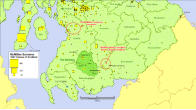
McMillan Surname Distribution:
Click to enlarge


Click to Enlarge

Click images to enlarge:
